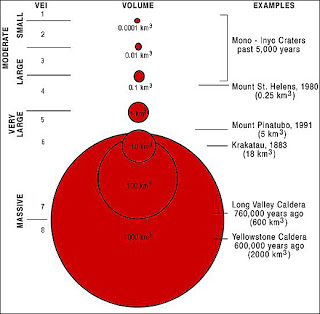Volcanic eruptions are ranked on a scale ranging from 1 to 8 called the Volcanic Explosivity Index, or VEI. As the relative size of the circles representing the volume of ash and ejecta show, the last major Yellowstone Caldera eruption, more than 600,000 years ago, dwarfs that of “typical” volcanoes, like Mount St Helens.
National Geographic and other sources report that Yellowstone National Park’s supervolcano just took a deep “breath,” causing miles of ground to rise dramatically, scientists report.
Volcanologists with the U.S. Geological Survey believe that supervolcanoes are likely to give decades — even centuries — of warning signs before they erupt.
* Beginning in 2004, scientists saw the ground above the caldera rise upward at rates as high as 2.8 inches (7 centimeters) a year
* The rate slowed between 2007 and 2010 to a centimeter a year or less.
* since the start of the swelling, ground levels over the volcano have been raised by as much as 10 inches (25 centimeters) in places.
“At the beginning we were concerned it could be leading up to an eruption,” said Smith, who co-authored a paper on the surge published in the December 3, 2010, edition of Geophysical Research Letters.
“But once we saw [the magma] was at a depth of ten kilometers, we weren’t so concerned. If it had been at depths of two or three kilometers [one or two miles], we’d have been a lot more concerned.
The last three super-volcano-eruptions have been in Yellowstone itself. The most recent, 640,000 years ago, was a thousand times the size of the Mount St. Helens eruption in 1980, which killed 57 people in Washington. But numbers do not capture the full scope of the mayhem. Scientists calculate that the pillar of ash from the Yellowstone explosion rose some 100,000 feet, leaving a layer of debris across the West all the way to the Gulf of Mexico. Pyroclastic flows—dense, lethal fogs of ash, rocks, and gas, superheated to 1,470 degrees Fahrenheit—rolled across the landscape in towering gray clouds. The clouds filled entire valleys with hundreds of feet of material so hot and heavy that it welded itself like asphalt across the once verdant landscape. And this wasn’t even Yellowstone’s most violent moment. An eruption 2.1 million years ago was more than twice as strong, leaving a hole in the ground the size of Rhode Island. In between, 1.3 million years ago, was a smaller but still devastating eruption.
Volcanologists with the U.S. Geological Survey believe that supervolcanoes are likely to give decades — even centuries — of warning signs before they erupt. The scientists think those signs would include lots of earthquakes, massive bulging of the land, an increase in small eruptions, “swarms” of earthquakes in specific areas, changes in the chemical composition of lavas from smaller eruptions, changes in gasses escaping the ground and, possibly, large-scale cracking of the land.
None of those indicators are present at Yellowstone, says Smith.
There is no argument that a major eruption at Yellowstone in modern times would be devastating. It would obliterate the national park and nearby communities, spread ground-glass-like volcanic ash from the Pacific coast to the Midwest, and cause worldwide weather changes from the airborne dust and gases, according to Smith, who described the potential effects in detail in his book Windows Into the Earth, published in 2000.
A modern full-force Yellowstone eruption could kill millions, directly and indirectly, and would make every volcano in recorded human history look minor by comparison.
If you liked this article, please give it a quick review on ycombinator or StumbleUpon. Thanks

Brian Wang is a Futurist Thought Leader and a popular Science blogger with 1 million readers per month. His blog Nextbigfuture.com is ranked #1 Science News Blog. It covers many disruptive technology and trends including Space, Robotics, Artificial Intelligence, Medicine, Anti-aging Biotechnology, and Nanotechnology.
Known for identifying cutting edge technologies, he is currently a Co-Founder of a startup and fundraiser for high potential early-stage companies. He is the Head of Research for Allocations for deep technology investments and an Angel Investor at Space Angels.
A frequent speaker at corporations, he has been a TEDx speaker, a Singularity University speaker and guest at numerous interviews for radio and podcasts. He is open to public speaking and advising engagements.


